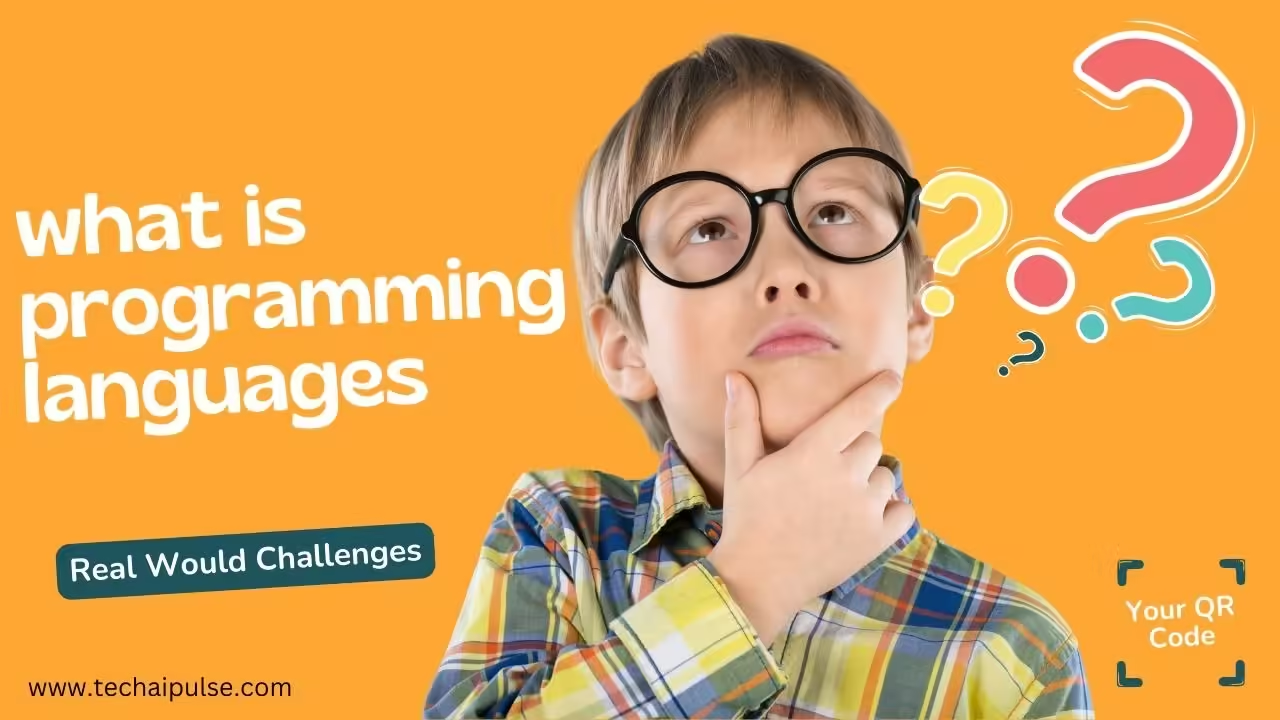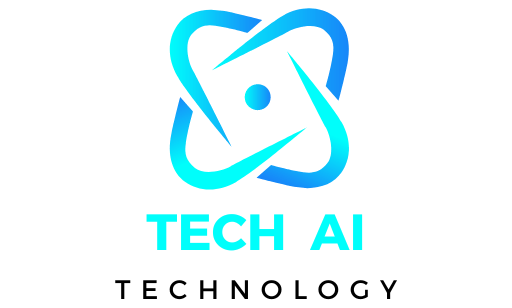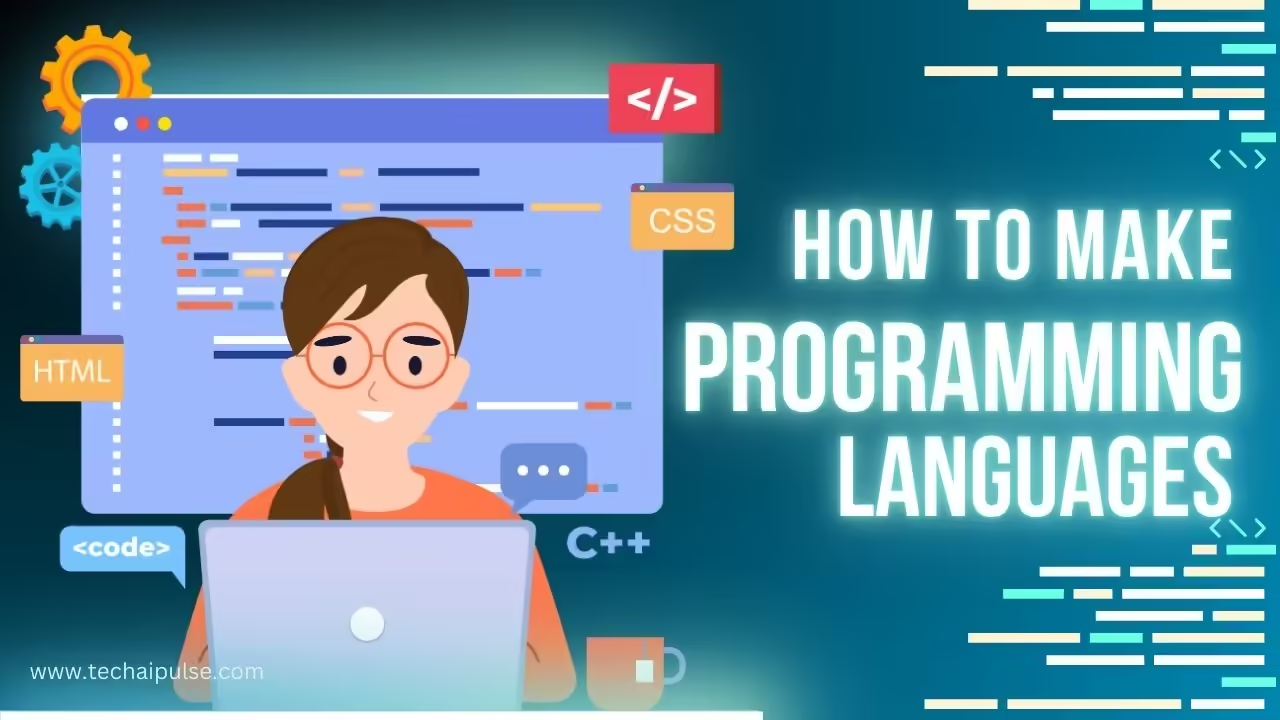Have you ever wondered how to make your own programming language? In 2025, with the rise of AI driven development and advanced compiler tools, creating a custom language is more accessible than ever.
Whether you want to build a domain specific language (DSL) for automation, optimize performance with a low level syntax, or experiment with new programming paradigms, this guide will walk you through the latest techniques. From defining syntax and grammar to writing a lexer, parser, and interpreter, you’ll learn every essential step. Let’s dive into the future of programming and bring your own language to life!
How to Make Your Own Programming Language in 2025
Creating your own programming language may seem complex, but with modern tools and techniques, it’s more accessible than ever. To build a custom language, you need to define its syntax, develop a lexer and parser, and implement an interpreter or compiler.
Whether you’re designing a simple scripting language or a full fledged compiled language, understanding language design principles is essential. This guide will walk you through every step, from concept to execution, using the latest advancements in 2025. Let’s dive into how you can create a programming language from scratch!
Why Create Your Own Programming Language?

Developing a programming language allows you to optimize for specific use cases, such as AI programming, automation, or low level system control. Many developers create custom languages to simplify tasks, improve performance, or experiment with new paradigms.
With AI assisted development, writing a language from scratch has become easier, enabling faster prototyping and testing.
Step 1: Define the Purpose and Syntax
Before coding, determine why your language exists and what problem it solves. Will it be high level like Python or low level like C? Define the syntax, rules, and keywords. A language with simple syntax improves readability, while a structured syntax ensures better performance and scalability.
Step 2: Build a Lexer for Tokenization
The lexer (lexical analyzer) processes code into tokens basic building blocks like keywords, operators, and identifiers. Tokenization simplifies parsing and makes interpretation efficient. In 2025, AI powered lexers can automate some of this work, making it faster to implement.
Step 3: Develop a Parser for Syntax Analysis
A parser takes the tokens and structures them according to grammar rules. There are two main types of parsers:
- Top down parsers, which analyze code recursively.
- Bottom up parsers, which build syntax trees from tokens.
Using a parser generator like ANTLR or LLVM can significantly speed up development.
Step 4: Implement an Interpreter or Compiler
An interpreter executes code directly, while a compiler translates it into machine code. Interpreted languages like JavaScript run instantly, whereas compiled languages like C++ offer better performance. Choose the best approach based on your language’s purpose. AI assisted compilers in 2025 can optimize code for faster execution.
Step 5: Create a Standard Library and Error Handling
A well designed language includes a standard library for essential functions like file handling, networking, and mathematical operations. Error handling is also crucial detailed error messages improve debugging and developer experience. In 2025, AI driven debugging tools can enhance error reporting.
Step 6: Test, Optimize, and Release Your Language
Once your language is functional, test it with sample programs. Benchmark performance, optimize execution speed, and refine syntax based on feedback. Modern AI tools can help analyze performance bottlenecks and suggest improvements. Finally, document your language and release it to developers for testing.
Why Create Your Own Programming Language?
Creating your own programming language offers unique advantages. It allows you to solve specific problems in AI, automation, and game development. Custom languages optimize performance by tailoring execution for efficiency.
Developers can experiment with new paradigms like functional, declarative, or hybrid approaches. Learning and research improve through a deeper understanding of compilers and interpreters. Domain specific languages (DSLs) help industries like finance, healthcare, and cybersecurity streamline complex operations.
Solving Specific Problems
Different fields require specialized programming solutions. AI programming languages improve machine learning workflows. Automation languages enhance scripting efficiency. Game development benefits from custom engines with real time rendering optimization. Tailored syntax and execution models solve industry specific challenges.
Performance Optimization
Custom languages improve execution speed and memory usage. Unlike general purpose programming languages, they remove unnecessary overhead. Low level optimizations enable faster calculations and better system performance. Industries with real time processing demands benefit the most.
Experimenting with New Paradigms
New programming paradigms drive innovation. Functional programming languages eliminate side effects, improving maintainability. Declarative programming simplifies complex logic with high level expressions. Hybrid languages combine strengths from multiple paradigms for flexible development.
Learning and Research
Creating a programming language deepens understanding of compilers, interpreters, and syntax trees. It teaches how code is parsed, optimized, and executed. Researchers use language creation to test new computing theories. It enhances problem solving skills and software engineering expertise.
Building Domain Specific Languages (DSLs)
DSLs improve efficiency in specialized industries. Financial modeling benefits from high precision arithmetic and risk analysis tools. Healthcare software gains secure, regulation compliant scripting. Cybersecurity systems use DSLs to define threat detection rules. Industry specific languages streamline workflows and boost productivity.
Building a programming language is a powerful way to push technology forward. It enhances problem solving, performance, and innovation. Whether for AI, game development, or research, custom languages offer limitless possibilities.
Understanding the Basics of Language Design

Programming languages have unique structures and rules that define how they work. Understanding language design helps developers choose the right language for a project. Key concepts include high level vs. low level languages, syntax vs. semantics, lexical structure, parsing, and memory management. These elements shape how code is written, interpreted, and executed.
High Level vs. Low Level Languages
Programming languages fall into two categories: high level and low level. High level languages like Python and Java are easier to read and write. They use abstraction to simplify complex operations. Low level languages, such as Assembly and C, provide more control over hardware.
They require manual memory management and offer better performance. Interpreted languages execute code line by line, while compiled languages translate code into machine language before running.
Syntax vs. Semantics
Syntax defines how code should be structured. It includes rules for writing variables, loops, and functions. Semantics refers to what the code actually does. Even if the syntax is correct, incorrect semantics can cause logic errors. For example, int x = “hello”; is syntactically correct in some languages but semantically incorrect because a string cannot be assigned to an integer.
Lexical Structure
The lexical structure of a language includes keywords, variables, operators, and expressions. Keywords are reserved words like if, while, and return. Variables store data values, while operators (+, -, *, /) perform operations. Expressions combine these elements to create meaningful code. Proper tokenization of these components is essential for parsing.
Parsing and Grammar Rules
Parsing ensures that code follows proper grammar rules. Many languages use Backus Naur Form (BNF) notation to define syntax rules. Recursive descent parsing is a common technique to analyze nested expressions. These processes help convert human readable code into machine executable instructions.
Memory Management Strategies
Efficient memory management prevents performance issues. Some languages, like C, require manual memory allocation using malloc() and free(). Others, like Python and Java, use garbage collection to automatically free unused memory. Choosing the right strategy impacts speed, efficiency, and system resources.
Step by Step Guide to Creating a Programming Language in 2025
Step 1: Define the Language Purpose & Features
A programming language must solve specific problems efficiently. Decide if it will be statically or dynamically typed for better safety or flexibility. Consider concurrency models like multithreading or async processing. Choose a paradigm such as functional, object oriented, or procedural to shape how the language operates.
Step 2: Design the Syntax & Grammar
A clear and scalable syntax improves readability. Define essential keywords, data types, and operators. Utilize established grammar frameworks like BNF, PEG, or EBNF to formalize rules. AI tools now assist in optimizing syntax for better performance and adoption.
Step 3: Develop the Lexer (Lexical Analyzer)
A lexer breaks the source code into tokens, handling identifiers, numbers, strings, and special characters. AI assisted lexers in 2025 can improve tokenization efficiency. Popular tools include Lex, Flex, and scripting solutions in Python or Go.
Step 4: Build the Parser (Syntax Analyzer)
A parser converts tokens into an abstract syntax tree (AST). Choose between top down parsing (LL) or bottom up parsing (LR) for structured analysis. Implement robust error handling to report syntax issues. Use ANTLR, Bison, or PEG.js for automation.
Step 5: Implement the Interpreter or Compiler
Decide if your language will be interpreted (Python, JavaScript) or compiled (C++, Rust). Use LLVM for efficient code compilation. AI powered code optimization in 2025 enhances performance, reducing execution time and improving memory usage.
Step 6: Memory Management & Garbage Collection
Choose between stack vs. heap allocation. Implement automatic or manual memory management depending on language needs. Garbage collection methods like Reference Counting, Mark & Sweep, and Tracing GC improve efficiency.
Step 7: Error Handling & Debugging
Design clear error messages for syntax and runtime issues. AI driven debugging tools in 2025 provide intelligent suggestions. Implement logging systems for deep diagnostics and efficient troubleshooting.
Advanced Features for a Modern Programming Language

Programming languages in 2025 are evolving rapidly. Developers need advanced tools to build scalable, secure, and efficient applications. Here are five cutting edge features every modern programming language should have.
1. Concurrency Support (Async Programming & Multithreading)
Efficient multitasking is crucial for high performance applications. Asynchronous programming allows non blocking execution, improving responsiveness. Multithreading enables parallel task execution, maximizing CPU utilization.
Languages like Rust, Go, and Kotlin offer robust concurrency models. Developers rely on coroutines, event loops, and thread pools for scalable software development.
2. AI Powered Code Suggestions & Optimizations
AI driven development boosts productivity. Modern languages integrate AI powered code suggestions, automated refactoring, and intelligent debugging. Tools like GitHub Copilot, Tabnine, and ChatGPT Code Interpreter enhance coding efficiency.
Predictive algorithms help identify performance bottlenecks, redundant code, and security risks. These smart features streamline software development.
3. Security Focused Language Design (Sandboxing & Memory Safety)
Security is a top priority in software engineering. Modern languages enforce memory safety, sandboxing, and secure coding practices. Rust eliminates buffer overflows with its ownership model. Sandboxing restricts untrusted code execution, preventing vulnerabilities. Languages like Swift and TypeScript focus on type safety, preventing injection attacks and runtime errors.
4. Interoperability with Existing Languages (C, Python, Java)
Seamless integration with legacy systems is essential. Advanced languages support cross language compatibility, foreign function interfaces (FFI), and runtime linking. Developers use Python for AI, C for system programming, and Java for enterprise applications. Languages like Kotlin, Dart, and Julia enable smooth interaction between different ecosystems.
5. Cloud Native Compatibility (Deployment Friendly Syntax)
Cloud computing dominates modern software architecture. Cloud native programming languages optimize performance for serverless computing, microservices, and containerization. Lightweight syntax simplifies Kubernetes deployments, API integrations, and edge computing. Languages like Go, TypeScript, and Swift offer built in cloud support, reducing infrastructure complexity.
Testing and Optimization in Programming: Best Practices for 2025
Unit Testing for Language Features
Unit testing ensures code reliability. Developers use unit tests to verify individual components of a programming language. Testing frameworks like Jest, Mocha, and PyTest help detect bugs early. Automated testing speeds up development and reduces human errors. Writing effective test cases improves software quality and maintainability.
Benchmarking Execution Speed
Benchmarking helps measure a program’s efficiency. Developers compare execution time using benchmarking tools like Google Benchmark, JMH (Java Microbenchmark Harness), and PyPerformance. Speed tests identify slow functions, improving software responsiveness. Optimizing code through benchmarking ensures faster execution and better scalability.
Optimizing for Low Memory Footprint and High Performance
Memory optimization enhances application efficiency. Developers reduce RAM usage by implementing memory management techniques like garbage collection and object pooling. Code refactoring minimizes memory leaks. Lightweight data structures and efficient algorithms improve performance. Cloud based optimization ensures scalability in modern applications.
Profiling Tools for Performance Improvement
Profiling tools analyze code behavior. Performance profilers like Perf, Valgrind, and Chrome DevTools help detect bottlenecks. CPU and memory profiling identify inefficient resource usage. Debugging and optimizing critical code sections enhance application speed. Profiling ensures smooth user experience and optimal system performance.
This structured approach ensures efficient, high performing applications. 🚀
Building a Standard Library and Development Tools: Essential Steps for 2025
Developing a programming language requires a robust standard library and modern development tools. In 2025, the focus is on efficiency, AI powered automation, and seamless user experience. Below are the key aspects of building a standard library and creating cutting edge development tools.
1. Creating Essential Libraries for Efficient Development
A standard library provides fundamental functionalities like file I/O, networking, and data structures. These core components ensure reliability and performance in software development.
- File I/O: Enables reading and writing data efficiently. Modern libraries support asynchronous operations and cloud storage integration.
- Networking: Handles HTTP requests, WebSockets, and secure data transmission for real time applications.
- Data Structures: Includes optimized hash tables, graphs, and concurrent data structures for scalable performance.
In 2025, developers prioritize performance, modularity, and security when building essential libraries.
2. Developing an IDE or Code Editor with Advanced Features
A well designed Integrated Development Environment (IDE) or code editor enhances developer productivity. Modern IDEs include:
- Syntax highlighting: Helps identify keywords, variables, and functions quickly.
- Code linting: Detects errors and enforces best practices automatically.
- Version control integration: Seamlessly connects with Git, GitHub, and GitLab for efficient collaboration.
User friendly interfaces, real time debugging, and AI assisted suggestions are must have features in 2025.
3. AI Powered Code Completion and Automation
AI driven tools accelerate coding, reduce errors, and optimize performance. Key advancements in 2025 include:
- AI based autocomplete: Predicts code snippets based on context.
- Automated bug detection: Identifies vulnerabilities before deployment.
- Natural language coding: Converts spoken or written descriptions into executable code.
Tools like GitHub Copilot, Tabnine, and OpenAI Codex are evolving, making coding more intuitive and efficient.
Documentation and Community Support
Clear documentation is key to helping developers understand and use your project. Well structured guides, API references, and code examples make it easier for users to implement features. Good documentation improves adoption and reduces confusion. It should include setup instructions, troubleshooting tips, and best practices.
A GitHub repository is essential for open source projects. It allows developers to collaborate, report issues, and contribute improvements. Adding a README file with clear installation steps, usage examples, and contribution guidelines makes it more accessible. Version control, pull requests, and issue tracking improve collaboration.
Community engagement boosts visibility and trust. Active participation in forums, blogs, and social media attracts developers and potential users. Answering questions, sharing tutorials, and providing updates keep the community engaged. A strong developer community leads to continuous improvements and better adoption.
9 Steps to Releasing Your Programming Language Successfully in 2025
Creating a new programming language is exciting, but releasing it requires strategic planning. You need a clear licensing model, efficient distribution, and developer engagement. Here’s how to launch your programming language effectively in 2025.
1. Choosing an Open Source or Proprietary License
Deciding between open source and proprietary licensing impacts adoption and control. Open source licenses like MIT, GPL, or Apache encourage community driven development. Proprietary licenses ensure full control but may limit widespread use. Choose a model based on your goals open collaboration or commercial success.
2. Creating a Package Manager for Easier Adoption
A package manager simplifies installation and dependency management. Developers prefer built in tools that handle libraries efficiently. Consider creating a package manager or integrating with existing ones like NPM, PyPI, or Cargo. Seamless dependency handling improves usability and adoption.
3. Setting Up a Developer Friendly Ecosystem
Provide well documented APIs, SDKs, and a user friendly standard library. Developers need clear examples, tutorials, and guides. A strong ecosystem includes debugging tools, code editors, and integrations with popular IDEs like VS Code and JetBrains.
4. Building a Strong Community for Growth
A thriving developer community accelerates adoption. Use GitHub, Discord, and Reddit to engage users. Open discussions, issue tracking, and active support increase trust. Regular updates and direct feedback loops strengthen community involvement.
5. Ensuring Performance and Security Optimization
Fast execution and secure coding practices make a language reliable. Optimize your compiler or interpreter for speed. Implement security best practices like memory safety, sandboxing, and robust error handling. A well optimized language attracts serious developers.
6. Getting Developer Feedback and Continuous Improvement
User feedback shapes the future of your language. Set up beta testing programs and collect insights from early adopters. Encourage issue reporting and feature requests. Regular updates based on feedback keep the language relevant.
7. Launching with a Strong Marketing and Documentation Strategy
Effective marketing boosts awareness. Create a professional website with a well structured documentation portal. Publish tutorials, case studies, and real world examples. Engaging blog posts, social media campaigns, and developer conferences drive visibility.
8. Integrating AI Powered Development Tools
AI enhanced coding tools improve developer experience. Implement AI based code suggestions, auto completions, and real time debugging. AI driven static analysis helps prevent common programming errors and enhances code quality.
9. Future Proofing with Scalability and Compatibility
Ensure your language scales for various applications, from web development to AI programming. Maintain backward compatibility to prevent breaking changes. Offer multi platform support for Linux, Windows, and macOS to maximize reach.
10 Future Trends in Programming Language Development (2025 & Beyond)

The world of programming is evolving rapidly. Emerging technologies like AI, quantum computing, and automation are shaping the next generation of programming languages. Here are the top trends expected to redefine coding in 2025 and beyond.
1. The Rise of AI Generated Programming Languages
Artificial intelligence is revolutionizing how programming languages are created. AI driven language models are developing new syntaxes optimized for machine learning and automation. These AI generated languages will streamline software development, reducing human coding errors and boosting efficiency.
Related Trends:
- AI assisted code generation
- Automated language evolution
- AI driven syntax optimization
2. Quantum Computing Friendly Languages
Quantum computing is advancing, requiring new programming paradigms. Languages like Q# and Quipper are evolving to handle complex quantum algorithms. Future programming languages will focus on qubit manipulation, quantum entanglement, and error correction techniques, making quantum development more accessible.
Key Developments:
- Enhanced quantum libraries
- Hybrid classical quantum programming
- Improved quantum debugging tools
3. Low Code & No Code Integrations
Low code and no code platforms are transforming software development. These frameworks enable rapid application creation with minimal manual coding. Future programming languages will integrate low code features, allowing developers to build software faster and with fewer errors.
Industry Impacts:
- Faster app development cycles
- Increased accessibility for non developers
- AI driven automation in low code tools
4. AI Powered Debugging & Compiler Optimizations
Debugging and compilation are becoming more efficient with AI. Modern compilers now leverage machine learning to detect errors, optimize performance, and enhance security. Future languages will integrate AI driven debugging tools, reducing development time and improving code reliability.
Key Features:
- Predictive error detection
- AI powered code refactoring
- Automated performance tuning
5. The Expansion of Domain Specific Languages (DSLs)
Domain specific languages (DSLs) are gaining traction. These specialized languages optimize development for fields like cybersecurity, blockchain, and bioinformatics. Expect more DSLs tailored to specific industries, enhancing efficiency and security.
Emerging Areas:
- Blockchain programming languages
- AI and ML specific coding languages
- Cybersecurity focused DSLs
6. Enhanced Security Features in Modern Languages
Cybersecurity threats are increasing, pushing programming languages to adopt stronger security measures. Future languages will integrate built in security features like memory safety, end to end encryption, and AI driven vulnerability detection.
Key Innovations:
- Auto sanitization of user inputs
- AI assisted threat analysis
- Improved encryption protocols
7. Increased Popularity of Multi Paradigm Languages
Languages that support multiple paradigms are becoming more prevalent. Combining object oriented, functional, and procedural programming, multi paradigm languages improve flexibility and scalability. Expect more hybrid languages that cater to diverse programming needs.
Notable Examples:
- Rust (combining functional and systems programming)
- Julia (optimized for scientific computing)
- Kotlin (blending OOP and functional programming)
8. Rise of Performance Oriented Languages
Efficiency is key in modern development. Languages optimized for speed and resource management, like Rust and Zig, are gaining popularity. Future programming languages will emphasize performance, scalability, and minimal system overhead.
Advantages:
- Faster execution times
- Lower memory consumption
- Optimized for high performance computing
9. Integration of Natural Language Processing (NLP) in Coding
NLP is changing how developers interact with code. Future languages may incorporate NLP driven syntax, allowing developers to write code using natural language commands. This will enhance accessibility and reduce the learning curve for new programmers.
NLP in Coding:
- Voice assisted programming
- AI powered code documentation
- Conversational debugging assistants
10. Sustainable & Energy Efficient Coding Practices
Eco-friendly coding is gaining importance. Future programming languages will focus on energy efficient computations, reducing carbon footprints. Green coding practices will become a priority for large scale applications and cloud computing environments.
Sustainability Trends:
- Low energy algorithms
- Optimized cloud computing resource management
- AI driven efficiency enhancements
FAQs:
Q1. Can I create my own programming language from scratch?
Yes, you can build your own programming language from scratch by designing its syntax, creating a lexer, parser, and implementing an interpreter or compiler. Modern tools like ANTLR, LLVM, and AI assisted code generators make the process easier in 2025.
Q2. Do I need to be an expert in programming to create a language?
While advanced programming knowledge helps, you can start with basic compiler concepts and use existing frameworks. Learning about lexical analysis, parsing, and memory management is essential.
Q3. What is the best programming language to build a new language?
Languages like C, C++, Rust, Python, and Go are commonly used. C++ and Rust are ideal for compiled languages, while Python is great for scripting and interpreted languages.
Q4. Should I create an interpreted or compiled language?
It depends on your goals. Interpreted languages (like Python) are easier to develop and test, while compiled languages (like C++ or Rust) offer better performance.
Q5. How long does it take to build a programming language?
A simple scripting language can be created in a few weeks, while a fully functional language with an ecosystem may take months or years, depending on complexity.
Q6. What tools and frameworks help in programming language development?
Popular tools include:
- ANTLR, Bison, and Flex for parsing
- LLVM for compiling
- Python, Rust, or C++ for implementation
- AI powered code generation for optimizing syntax and grammar
Q7. How do I make my programming language user friendly?
Ensure clean syntax, good error handling, clear documentation, and an intuitive standard library. Providing IDE support with syntax highlighting and auto completion helps adoption.
Q8. Can AI help in creating a programming language?
Yes, AI in 2025 significantly improves language design, automates code generation, optimizes compilation, and enhances debugging tools for better performance.
Q9. What are the biggest challenges in creating a programming language?
Common challenges include designing a good syntax, handling memory management, creating an efficient parser, and gaining community adoption. Testing and debugging also require significant effort.
Q10. How do I publish and get developers to use my programming language?
Create an open source repository on GitHub, write documentation, build a package manager, and promote it on developer forums, blogs, and tech communities to gain users.
Conclusion:
Creating your own programming language in 2025 is more achievable than ever with modern tools and AI driven development. By defining clear syntax, building a strong parser, and optimizing performance, you can bring your language to life.
Whether for learning, innovation, or solving a specific problem, the journey is challenging but rewarding. Keep improving, engage with the developer community, and who knows—your language might be the next big thing! 🚀

